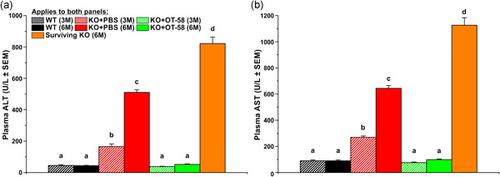当前位置:
X-MOL 学术
›
Hum. Mutat.
›
论文详情
Our official English website, www.x-mol.net, welcomes your
feedback! (Note: you will need to create a separate account there.)
Long-term uninterrupted enzyme replacement therapy prevents liver disease in murine model of severe homocystinuria.
Human Mutation ( IF 3.3 ) Pub Date : 2020-07-05 , DOI: 10.1002/humu.24072 Insun Park 1 , Helena Hůlková 2, 3 , Jakub Krijt 3 , Viktor Kožich 3 , Erez M Bublil 4 , Tomas Majtan 1
Human Mutation ( IF 3.3 ) Pub Date : 2020-07-05 , DOI: 10.1002/humu.24072 Insun Park 1 , Helena Hůlková 2, 3 , Jakub Krijt 3 , Viktor Kožich 3 , Erez M Bublil 4 , Tomas Majtan 1
Affiliation

|
Classical homocystinuria (HCU) is an inborn error of metabolism caused by loss of cystathionine β‐synthase (CBS) activity with the concomitant buildup of homocysteine. In knockout (KO) mice, a mouse model of HCU, complete lack of CBS is neonatally lethal. Administration of OT‐58, an enzyme therapy for HCU, during the first 5 weeks of life rescued KO mice survival by preventing liver disease. Here, we studied the impact of a long‐term uninterrupted OT‐58 treatment or its absence beyond the neonatal period on liver pathology and metabolism. Plasma and liver metabolites of KO mice on OT‐58 treatment were substantially improved or normalized compared with those receiving vehicle. Increased plasma activities of alanine aminotransferase and aspartate aminotransferase of vehicle‐injected KO mice suggested the progression of liver damage with age and lack of treatment. At 3 months of age, liver histology showed no signs of hepatopathy in both vehicle‐ and OT‐58‐treated KO mice. However, moderate to severe liver disease, characterized by steatosis, hepatocellular necroses, disorganized endoplasmic reticulum, and swollen mitochondria, developed in 6‐month‐old vehicle‐injected KO mice. KO mice on OT‐58 treatment remained asymptomatic and were indistinguishable from age‐matched healthy controls. Long‐term uninterrupted OT‐58 treatment was essential to prevent severe liver disease in the KO mouse model of HCU.
中文翻译:

长期不间断的酶替代疗法可预防严重高胱氨酸尿症小鼠模型的肝脏疾病。
经典型高半胱氨酸尿症 (HCU) 是一种先天性代谢缺陷,由胱硫醚 β-合酶 (CBS) 活性丧失并伴随高半胱氨酸的积累引起。在敲除 (KO) 小鼠(一种 HCU 小鼠模型)中,完全缺乏 CBS 对新生儿是致命的。OT-58 是 HCU 的一种酶疗法,在生命的前 5 周内通过预防肝脏疾病挽救了 KO 小鼠的存活。在这里,我们研究了长期不间断的 OT-58 治疗或在新生儿期后不治疗对肝脏病理和代谢的影响。与接受载体的小鼠相比,接受 OT-58 治疗的 KO 小鼠的血浆和肝脏代谢物得到显着改善或正常化。注射载体的 KO 小鼠的丙氨酸氨基转移酶和天冬氨酸氨基转移酶的血浆活性增加表明肝损伤随着年龄和缺乏治疗而进展。在 3 个月大时,肝脏组织学显示,在媒介物和 OT-58 处理的 KO 小鼠中均未出现肝病迹象。然而,在 6 个月大的注射了赋形剂的 KO 小鼠中出现了以脂肪变性、肝细胞坏死、内质网紊乱和线粒体肿胀为特征的中度至重度肝病。接受 OT-58 治疗的 KO 小鼠仍然没有症状,并且与年龄匹配的健康对照组无法区分。长期不间断的 OT-58 治疗对于预防 HCU KO 小鼠模型中的严重肝病至关重要。然而,在 6 个月大的注射了赋形剂的 KO 小鼠中出现了以脂肪变性、肝细胞坏死、内质网紊乱和线粒体肿胀为特征的中度至重度肝病。接受 OT-58 治疗的 KO 小鼠仍然没有症状,并且与年龄匹配的健康对照组无法区分。长期不间断的 OT-58 治疗对于预防 HCU KO 小鼠模型中的严重肝病至关重要。然而,在 6 个月大的注射了赋形剂的 KO 小鼠中出现了以脂肪变性、肝细胞坏死、内质网紊乱和线粒体肿胀为特征的中度至重度肝病。接受 OT-58 治疗的 KO 小鼠仍然没有症状,并且与年龄匹配的健康对照组无法区分。长期不间断的 OT-58 治疗对于预防 HCU KO 小鼠模型中的严重肝病至关重要。
更新日期:2020-08-27
中文翻译:

长期不间断的酶替代疗法可预防严重高胱氨酸尿症小鼠模型的肝脏疾病。
经典型高半胱氨酸尿症 (HCU) 是一种先天性代谢缺陷,由胱硫醚 β-合酶 (CBS) 活性丧失并伴随高半胱氨酸的积累引起。在敲除 (KO) 小鼠(一种 HCU 小鼠模型)中,完全缺乏 CBS 对新生儿是致命的。OT-58 是 HCU 的一种酶疗法,在生命的前 5 周内通过预防肝脏疾病挽救了 KO 小鼠的存活。在这里,我们研究了长期不间断的 OT-58 治疗或在新生儿期后不治疗对肝脏病理和代谢的影响。与接受载体的小鼠相比,接受 OT-58 治疗的 KO 小鼠的血浆和肝脏代谢物得到显着改善或正常化。注射载体的 KO 小鼠的丙氨酸氨基转移酶和天冬氨酸氨基转移酶的血浆活性增加表明肝损伤随着年龄和缺乏治疗而进展。在 3 个月大时,肝脏组织学显示,在媒介物和 OT-58 处理的 KO 小鼠中均未出现肝病迹象。然而,在 6 个月大的注射了赋形剂的 KO 小鼠中出现了以脂肪变性、肝细胞坏死、内质网紊乱和线粒体肿胀为特征的中度至重度肝病。接受 OT-58 治疗的 KO 小鼠仍然没有症状,并且与年龄匹配的健康对照组无法区分。长期不间断的 OT-58 治疗对于预防 HCU KO 小鼠模型中的严重肝病至关重要。然而,在 6 个月大的注射了赋形剂的 KO 小鼠中出现了以脂肪变性、肝细胞坏死、内质网紊乱和线粒体肿胀为特征的中度至重度肝病。接受 OT-58 治疗的 KO 小鼠仍然没有症状,并且与年龄匹配的健康对照组无法区分。长期不间断的 OT-58 治疗对于预防 HCU KO 小鼠模型中的严重肝病至关重要。然而,在 6 个月大的注射了赋形剂的 KO 小鼠中出现了以脂肪变性、肝细胞坏死、内质网紊乱和线粒体肿胀为特征的中度至重度肝病。接受 OT-58 治疗的 KO 小鼠仍然没有症状,并且与年龄匹配的健康对照组无法区分。长期不间断的 OT-58 治疗对于预防 HCU KO 小鼠模型中的严重肝病至关重要。











































 京公网安备 11010802027423号
京公网安备 11010802027423号